There is one destination that should be on everyone’s bucket list, and that is Lake Winnipeg. Situated in southern Manitoba, Lake Winnipeg boasts some of the best walleye fishing on the continent. In fact, it is going to be one of your best opportunities at breaking that 30” mark.
Lake Winnipeg’s out-of-this-world fishing isn’t the only thing that stands out. It’s accessibility and “fishability” as I like to call it, is easy. It’s not a tough lake to break down. With just a little bit of mobility, you can quickly find a lot of success on this body of water.
Therefore, when it comes to the incredible Manitoba fishing we all want to experience, there isn’t an easier destination to tackle than Lake Winnipeg.
PLANNING YOUR LAKE WINNIPEG TRIP
Over the course of the last 6 years, I’ve fished Lake Winnipeg well over a dozen times. The vast majority of these adventures (including my first time) have been complete DIY (Do it Yourself) style trips.
The first time we tackled “Big Windy”, we had no idea what we were getting into. Broken augers, flat truck tires, and being stranded on the lake were a few of the hard lessons learned that first time out on Lake Winnipeg ice.
In the end, we discovered it was all about preparation. That’s why I’ve decided to create the ultimate Lake Winnipeg DIY ice fishing guide.
Below I go through all of the details you need to know, including:
- Where to Stay
- Where to Access the Lake
- Gear You Should Bring
- How to Break Down the Lake
- Lures You Should Use
- Where to Get Your Bait and License(s)
- Why Anyone Can Conquer It
There is also plenty of information and insights on lessons learned in between.
ICE FISHING LAKE WINNIPEG
It only takes a quick glance at the map to recognize that Lake Winnipeg is a massive body of water. Given its size, the scope of this article focuses only on the southern basin. This DIY guide is primarily based on experiences on the ice from Gimli to Balsam Bay and down to the Red River. Due to location, accessibility, and accommodations, this is by far the most commonly fished area of the lake – especially for visiting Americans.
DECIDING WHEN TO GO

Ultimately, step one is simply determining when you want to go.
As long as the ice is safe, there isn’t a wrong time of the winter to head up to fish Lake Winnipeg. In fact, I’ve found success on Lake Winnipeg anywhere from January through the last week of March. However, it’s important to keep in mind that each of these times comes with trade-offs.
When determining when to go, be sure to consider the following:
- Colder vs. Warmer Weather Conditions
- Day Length
- Mobility (e.g. Snow Pack)
- Fishing Pressure
- How Much You Want to Deal with Crowds
JANUARY THROUGH FEBRUARY
They didn’t nickname Lake Winnipeg “Big Windy” for nothing. Weather can be very tough this time of year. Blizzard conditions and sub-zero temperatures are common, and trying to move to find fish in these extreme conditions can be nearly impossible. That’s why it’s important that you bring plenty of extra equipment.
Despite these tough conditions, there is a big benefit to fishing during this period: fewer people. That means there are more accommodations available and more space on the ice. Less pressure can also increase your chances of catching a trophy fish.
MARCH
With the warmer temperatures, longer days, and the fish starting to pile up shallow before the spawn – March is generally the most popular time of the year to hit Lake Winnipeg ice. However, with more anglers comes more pressure.
This, in combination with the warmer weather, also means accessing the lake can become difficult. Muddy, torn up roads and accesses, rough tracks, and plenty of commotion are things to expect this time of the year. Some of the muddier roads can’t even be accessed.
Both times of the year can produce incredible fishing.
So which one should you pick?
If you have tracks and a flip-over or plan on renting a snobear – earlier in the year might be the better choice. You’ll dodge the crowds and have just as great as an opportunity to catch a trophy as you would later in the year.
If you prefer warmer weather, spending more time fishing outdoors and staying mobile – then March is the time of year to go. When I take my friends and family, we almost always choose this time, simply because it’s more about the overall experience than just the catch.
Better yet, if you are like me, try them all! Once you catch your first Master Angler greenback, you will want to keep going back for more.
CHECK LAKE CONDITIONS
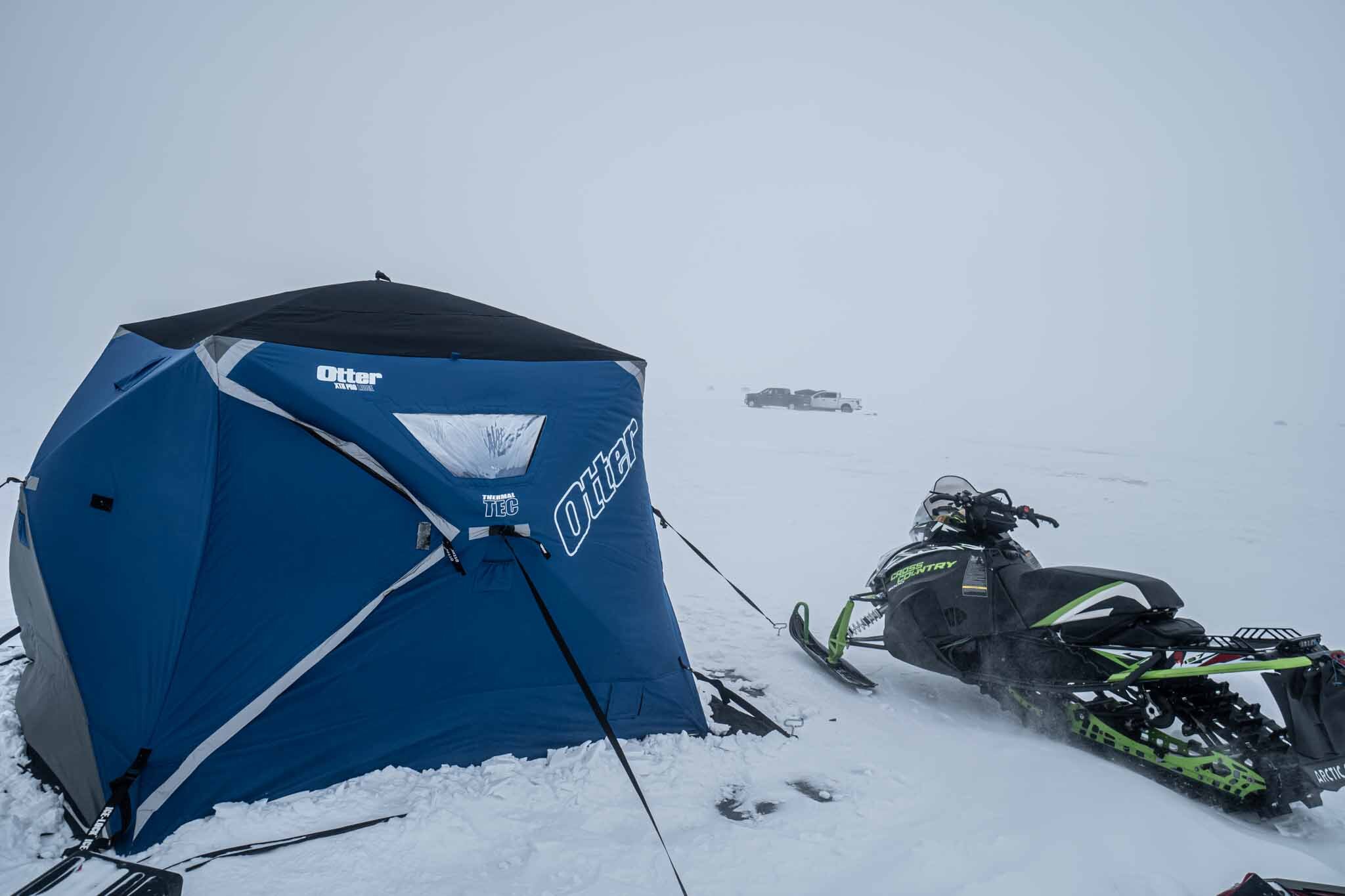
After you decide on a general time period, the next step is to check up on lake conditions BEFORE you travel. You’ll need to get some local boots-on-the-ground updates on ice conditions, determine what method of transportation you will need (e.g. tracks or trucks depending ice thickness and snow pack), and then start booking your accommodations accordingly. One of the best ways to do this is to contact local anglers. Whether it be the local bait shop or your friend on social media, being in touch with someone who fishes the lake regularly is your first step in planning. If you don’t know anyone up there or have social media to touch base with other anglers, here are a few other credible sources to get more information on lake conditions:
- Smoke N Fish Bait Shop in Selkirk, MB
- Online Forums (Manitoba Fishing Forum, for example)
- HuntFishMB Website
- Locals on Social Media (The Lake Winnipeg Report is a good Facebook group to check for updates)
DECIDE WHERE YOU WILL ACCESS THE LAKE
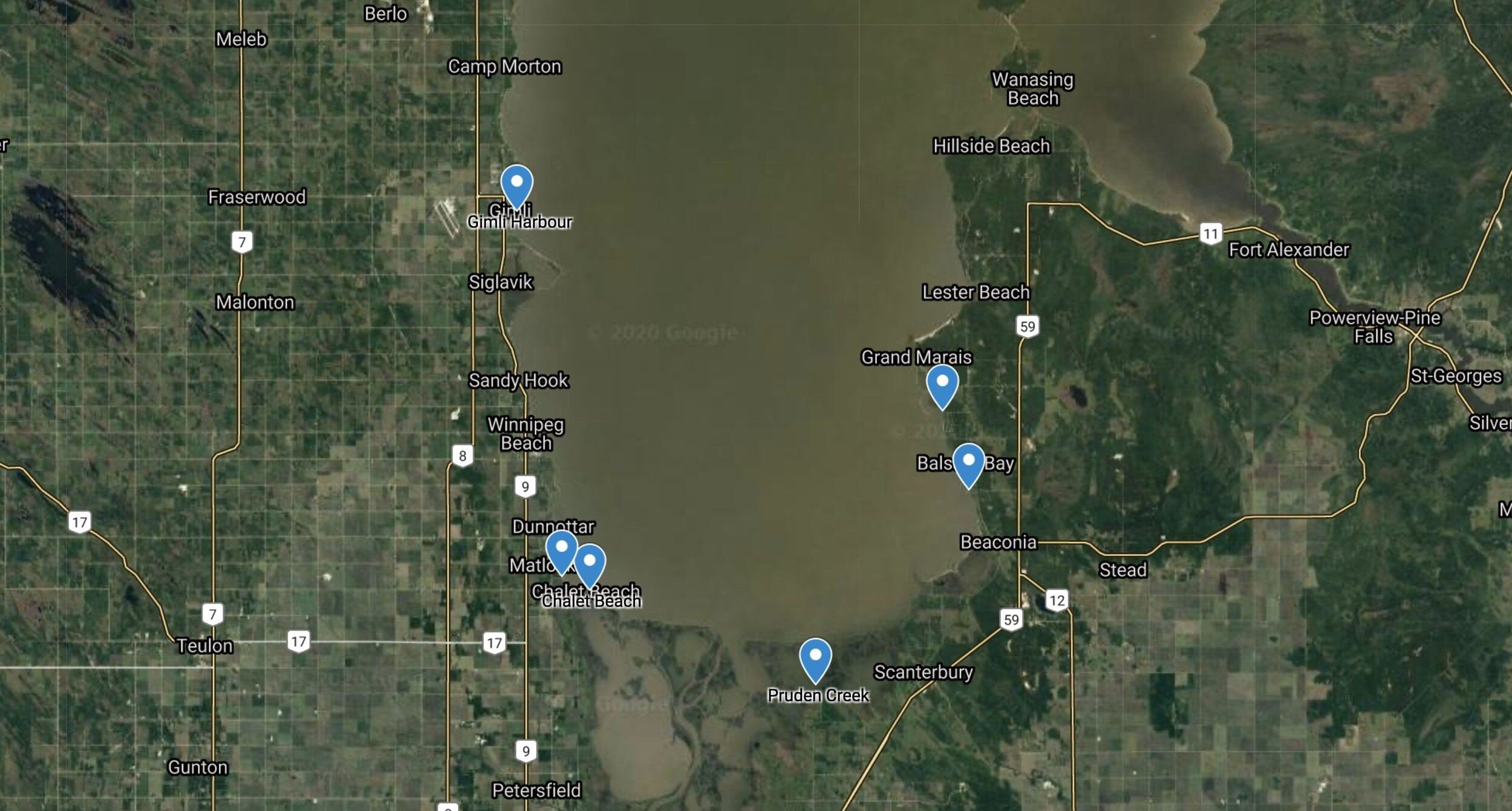
After you check ice and snow conditions and decide on your method of lake travel, you can determine which access you want to use to help determine where you should stay.
The Red River dumps into the south-central part of the southern basin and is a great identifier in determining where you should access the lake. There are plenty of accesses on the west side of the Red, the east side of the Red, or from the Red River itself.
THE RED RIVER
In the past, the Red River has been a great access point when staying at Selkirk. However, it isn’t always that way. Years with higher than average water levels and heavier snow conditions can make access here nearly impossible.
Later in the season, it also might get manually broken up for flood prevention. Therefore, it’s incredibly important to touch base with area locals before planning and trying to access the lake via the Red River River.
THE WEST SIDE OF THE RED RIVER
- Warner Road: For several trips now, we have went out of Warner Road on the west side of the lake. This access, in particular, is one of the most popular for truck traffic since it usually isn’t as drifted in as the east side. There is also plenty of parking space on the lake in front of this access. These reasons are why many people will make the truck trek from the west to the east side when the hit the ice despite the longer, rough ride across.
- Chalet Beach: This access is near the Warner Road access but doesn’t have as much parking accessibility. If Warner Road is packed, it might be worth checking out. However, I’ve always preferred Warner over Chalet.
- Gimli Harbour: Further north, Gimli is a great option for people staying in the city and choosing to fish up that way. However, one issue we have run into in the past is ice heaves or as the locals call them – ice ridges. If you plan on traveling south towards the Red, it’s quite a hike and travel can be difficult.
THE EAST SIDE OF THE RED
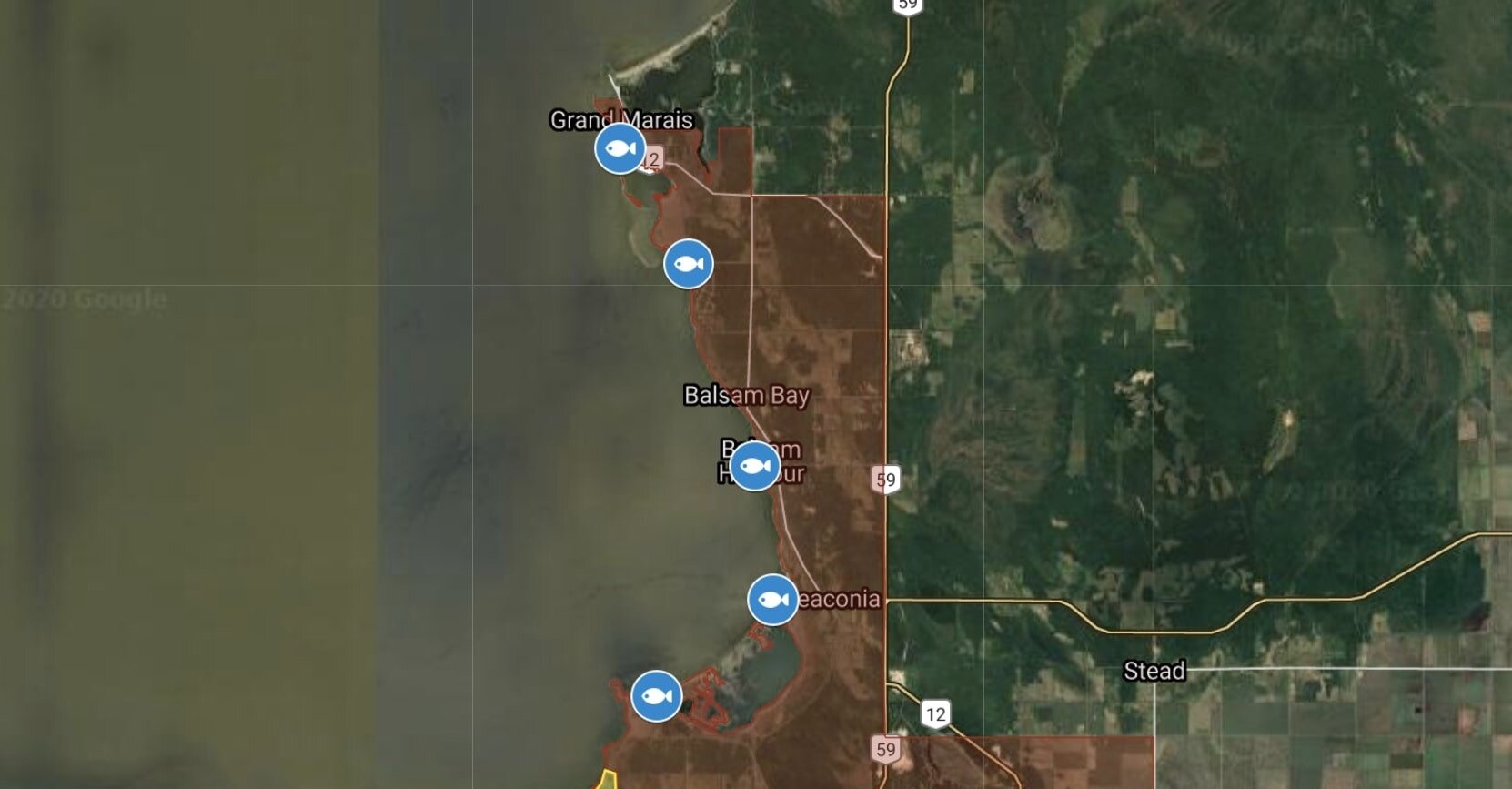
- Pruden Creek: This is our most commonly used access on the east side. Great for tracks or quads – its central location makes it an awesome option for those coming from the south.
Things to consider with Pruden Creek:
The winds frequently blow from the west and Northwest drifting in this access. Therefore, truck access is often pretty limited.
The creek is also accessed via a dirt trail, therefore in warmer weather conditions, the road can be impassible by snowmobiles or trucks (and people often get stuck). These are two things to consider when choosing this access.
- Balsam Harbour Access: A popular access on the east side when staying at the South Beach Casino. I’ve never used this access as we’ll generally stay in Selkirk or Gimli, but it is commonly used by many anglers.
- Beaconia Access: When conditions have been tough at Pruden, we have gone up to Beaconia when we want to fish the east side.
There are definitely other places you can access the lake from – especially by sled. However, these are a few of the staples that people typically choose when embarking on their own adventure.
PLACES TO STAY
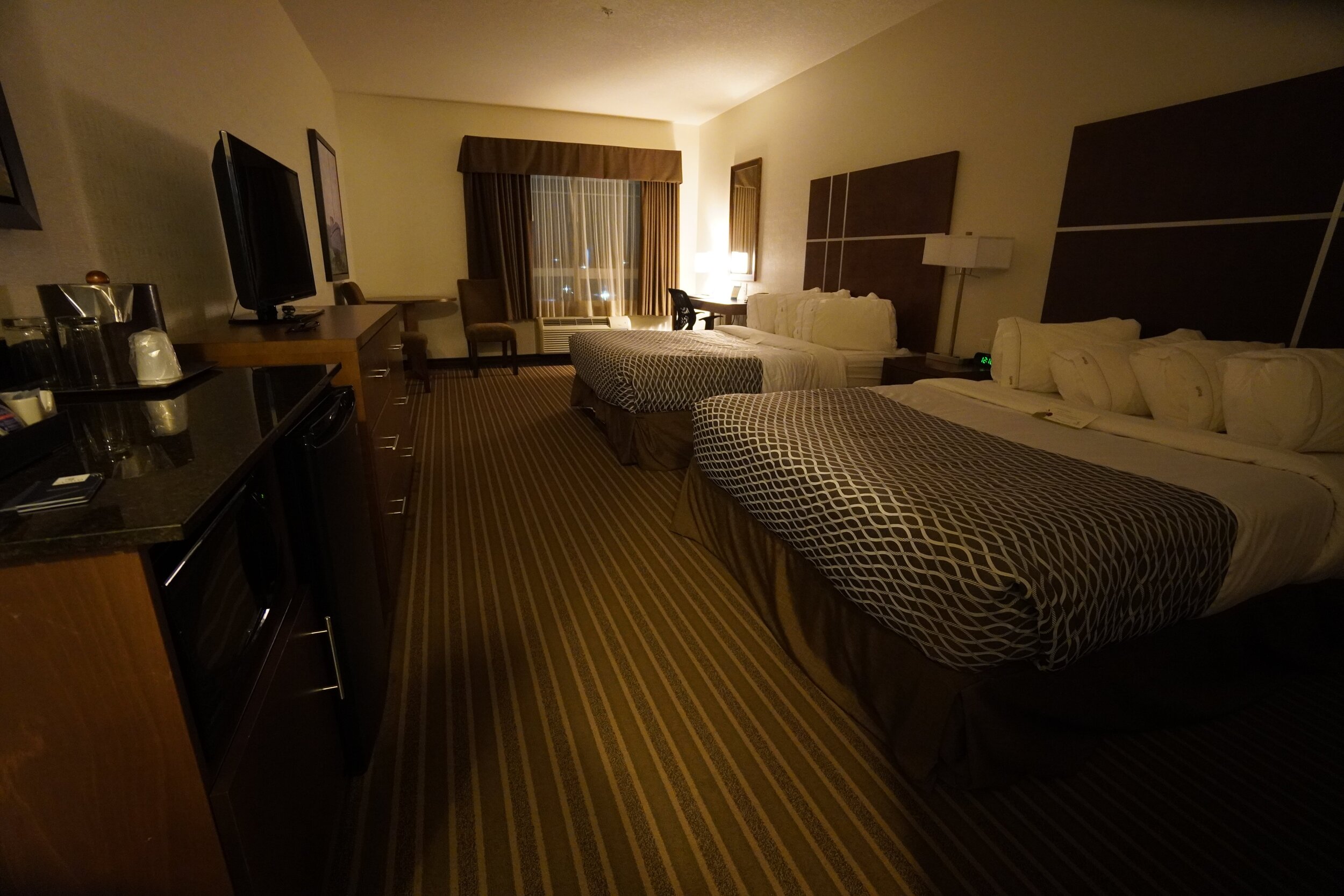
When it comes to accommodations, a great center point is Selkirk. Not only can you reach each side of the Red River quickly, but there are also plenty of accommodations and resources within the city itself. Whether you need a hotel, gas, bait, groceries, or a utility store – you will be able to find it in town. When given the choice, I almost always choose to stay in Selkirk for this reason.
However, there are plenty of options around other parts of the lakes. Here are a few I recommend that you look into:
- The Canalta (Selkirk)
- Lakeview Resort (Gimli – West)
- South Beach Casino (Scanterbury – East)
- Superior Inn and Conference Center (Beausejour – Southeast)
There are Airbnbs and other vacation rentals in Selkirk and the surrounding areas as well which can be a great option especially if you’re looking for a garage space to pull gear into at night or if you’re bringing up a large group of people. There are also plenty of options in the city of Winnipeg as well. It’s a bit of a drive, but the locals do it all of the time. If everything else is sold out – this is a good option.
GEAR
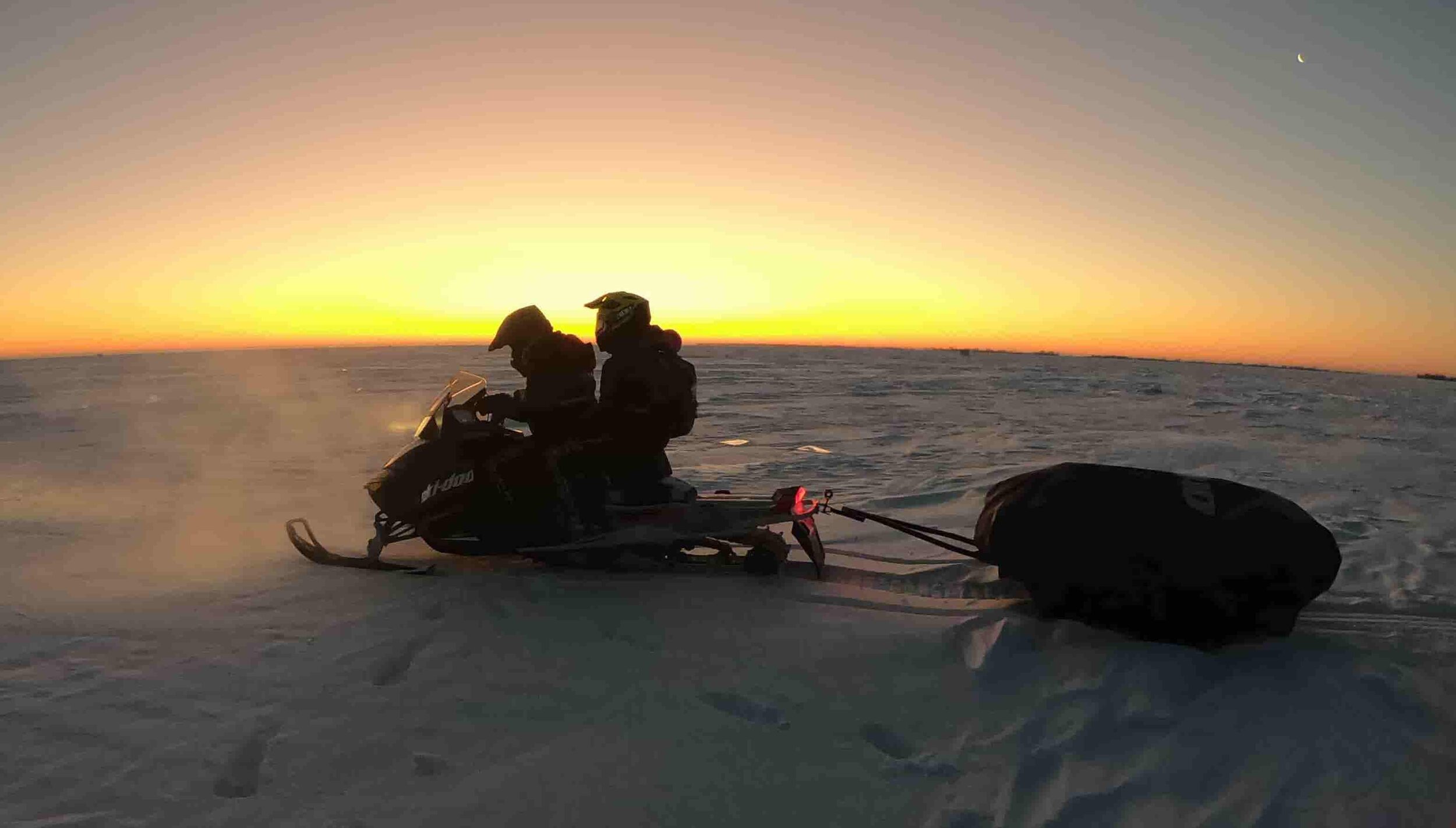
After you have your date and accommodations set – it’s time to get the gear ready. Just like with any ice trip, you are going to need the basics. The biggest difference on Lake Winnipeg is that you are also going to need all of your backups and spares.
Below I break down what I bring when heading up for an ice fishing trip on Lake Winnipeg.
RODS, REELS, & LINE
Between the fish being heavy and the hooks being barbless (which is MANDATORY in Manitoba) there is a huge benefit to using a heavier rod.
Anything with a medium to medium-heavy power and faster action tip is a great choice. Keeping that fish pinned is especially key when dealing with barbless lures. I’ve also found longer rods give me more leverage – and playing a big fish becomes much easier.
That’s why I choose to bring my St Croix Custom Ice Outside Eye. With its 36” length, medium power, and fast action tip – it offers plenty of leverage to pull those big fish in. I highly recommend it. For a backup, I also like to have my St Croix Tundra in a Medium Fast on hand.
As for reels, I’ve used the Daiwa Revros LT-1000 and a Daiwa QR 750. The LT is definitely a heavier duty option for a larger line, but the 750’s collapsable reel makes it great for a hard case.
As for line, I generally opt for using 10-lb braid with a 10-lb fluorocarbon leader but it wouldn’t hurt to go heavier. I prefer to run a looser drag, so line poundage is generally never a problem.
TRUCKS OR SLEDS

If there is plenty of ice and limited snow, using the truck is a great option. In fact, we have used a truck more times than not. One of the best things you can do is call ahead and check on ice and snow conditions. It also helps a lot to have good tires and, if you’re planning to travel with the truck on the ice, don’t forget to bring chains and a shovel and make sure you have a good tow strap. Whether you are traveling by truck or sled, I would always recommend that you don’t go it alone or, at the very least, make sure you know someone else on the ice or nearby that you can call if you get into trouble.
HUBS OR FLIP-OVERS
Hubs are great if you want to film and share the space with a larger group of people or even camp on the ice overnight. However, nothing beats the portability of a flip-over house. A flip-over with a snowmobile can get you through the windiest and most brutal days on the lake. If you are worried about the weather, I always recommend opting for a flip-over with tracks. This way you can stay mobile and your house isn’t going anywhere.
BRING AN AUGER EXTENSION
If you plan on heading up to Lake Winnipeg anytime from the end of January through March, I highly recommend you purchase an extension. I use the ION Alpha with an 8″ blade when I’m up there and am normally fine with a 12” extension even through March. However, keep in mind that the ice gets deep along pressure ridges and having a 20” extension on hand can’t hurt. Simply put, always bring the extension. If you’re a LiveScope or live sonar user like me, you’ll need to make sure you have an extension for your transducer as well.
LICENSES & REGULATIONS
You can purchase your fishing license ahead of your trip online at manitobaelicensing or pick it up at a gas station or bait shop on your way through Canada. I often would recommend stopping at Smoke N Fish in Selkirk (where you can also grab bait and gas before hitting the lake), but it’s gotten much easier to use Manitoba’s elicensing website in recent years. When purchasing online, you’ll need to create an account if you don’t already have one – using your Driver’s License # is the easiest method. Then, purchase the Non-Canadian Resident Annual Angling.
There are currently two license options for Non-Canadian Resident Anglers (Age 16 and Older):
- One Day: $19 CAD
- Annual: $55 CAD
As of the 2023 season: “The license must be carried on your person. This includes digital or hard copy and must be immediately produced at the request of an officer.” Therefore, I always recommend printing if off a copy – especially if you purchase your license online – but this does mean you can now carry an electronic copy on your phone. Just make sure you maintain your phone’s charge or you could be fined if you cannot show it to an officer – hence why I recommend the printed backup.
For Manitoba’s 2023 fishing regulations, click here: https://www.gov.mb.ca/nrnd/fish-wildlife/pubs/fish_wildlife/fish/angling-guide.pdf
If you want to keep fish, make sure check over the regulations thoroughly. As of 2023, you can keep a total of 4 walleye and sauger (either or combined) but you CANNOT keep any fish over 55cm (which is, safely speaking, about 21.5″) or anything under 35cm (about 13.75″). This means if you do land a Master Angler, it MUST go back in the water. In other words, you will have to get a replica if you land the fish of your lifetime.
A “Master Angler” qualifying walleye in Manitoba is 71 cm (28″). You can learn more about Manitoba’s Master Angler program and how to submit your catch here: https://anglers.travelmanitoba.com/master-angler-program/rules/
You can also find more Manitoba fishing info at the Hunt Fish MB website.
BAIT
As far as bait goes, frozen salted shiners are a great option. Live bait is allowed, but it isn’t as popular as it is south of the border. Often times I won’t tip my lure at all, but there have been tough bite days where the only thing that works is a simple jig with a live minnow.
Remember that in Manitoba, your lures MUST be barbless. You can bring up your usual tackle favorites, but you will need to make sure you pinch the barbs BEFORE tying them on your line. Without barbs, your bait will fall off the hook fairly often, especially when you’re running aggressive crank baits. Bringing along some bait buttons can make all the difference in keeping your lures tipped with bait for longer stretches.
EXTRA GEAR IS A MUST
The cold conditions and ice depth can definitely wear on gear faster. That’s why I always recommend that you bring as many extra items as you can. A few items that I’ve needed spares of in the past include:
- Auger: You will be drilling through an insane amount of ice. That’s hard on augers. Be prepared and always have an extra, batteries included.
- Heater: It can be 30 above or 30 below (Fahrenheit). Always be prepared for 30 below – in these conditions having a heater that works is a must for making or breaking your trip. Sometimes heaters freeze. Be prepared and carry plenty of propane.
- Tow Rope/Straps: If you are taking a truck, you might get stuck in drifts… a lot. Therefore, it’s always good to have a tow rope for these situations. I’ve also seen snowmobiles die on the ice and need a tow back to the trailer. Be prepared for it all.
- Flasher/Electronics Batteries: Batteries can fail out in the extreme cold. When you travel this far to ice fish, it’s always wise to have backup electronics.
Perhaps most important of all, however, is to go with a GROUP of people and have more than one method of transportation on the ice so you can help each other out of tough spots.
RECOMMENDED LURES

Aggressive and obnoxious lures often work well on Lake Winnipeg. I attribute this to plenty of food and plenty of competition. My staples when I head to Lake Winnipeg often have a rattle, flash, or both. A few of my go-to lures include:
- Lindy Rattl’N Flyer Spoon (use code NICOLE15 for a discount)
- Lipless crank baits: Rapala Rippin Raps, Rapala Slab Raps
- Large spoons with blades (such as PK Lures and VMC)
- and some Lindy Live Bait Jigs for those tough bite days (use NICOLE15 for a discount)
There isn’t really a “wrong” way to fish Winnipeg, but most of the time I find aggressive presentations turn over more fish, and bigger fish, than going subtle. Very rarely do I find success with dead sticks and tip ups, but you can use them – and live bait is legal.
Keep in mind that lures in Manitoba MUST be barbless. Don’t forget to pinch the barbs down on anything you’re using from home or you might face a fine.
Overall, what I have realized is that even on the slow days, the bite is much more aggressive then a typical “hot day” on my home waters. Keep that in mind when selecting your lures.
HOW TO FIND & CATCH FISH
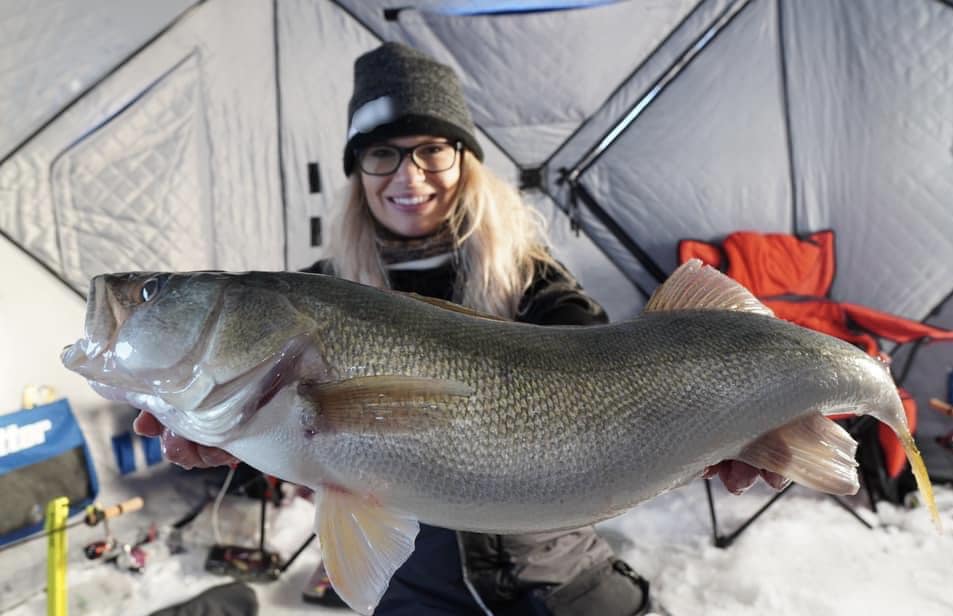
THERE IS STRUCTURE ON LAKE WINNIPEG
Despite what most people believe, Lake Winnipeg does have some structure – albeit not quite like we do back in Central Minnesota. LakeMaster has a map of the entire southern basin. It shows rock piles, break-lines, and a more accurate depth contour than Navionics. The new Humminbird One-Boat Network App also has a more defined chart that I’d recommend checking out.
However, it’s also important to understand that fish don’t hold to structure like they do in the rock basin lakes of Minnesota.
According to Mat Hobson from Ice Bound Excursions, the fish tend to hold near and off of the structure, instead of on top of it. They will often roam a certain area throughout the day, returning as daylight starts to recede. Sometimes drilling a pile of holes across a smaller area is the most consistent way to stay on fish, especially if someone is keeping an eye on them with live sonar.
Don’t be afraid to hold tight, however, especially if you setup a ton of gear inside a hub. If you are on them once, they will likely roam back through as the day progresses.
The key is to just initially find them and if you can find them schooled up, even better.
PRESSURE RIDGES (ICE HEAVES)
As with any body of water, a great place to start is along a pressure ridge. These areas provide extra oxygen and light, therefore being a perfect habitat for baitfish. Where there are baitfish – there are predators. Try shallow ridges earlier in the day and deeper ridges in the afternoon. It’s a great starting point, not only to find your trophy greenback but large numbers of roaming fish as well.
MOVE DEEPER DURING MID-AFTERNOON
Just like with most bodies of water, fish often move deeper during midday. If you have a mobile set up, you can start shallow (find some structure to set up along or a pressure ridge) and wait to see if you mark. If you mark fish – set up, fish for a while and see what you are catching. If you pull up one or two big fish over the course of a few hours, that pod of fish will likely be back. It’s just up to you if you wish to try to chase them deeper or not.
If you haven’t marked much fish (or have fished for half a day without finding any size), then I recommend moving until you do. The goal is to mark fish consistently – and ideally one or two decent fish – before completely committing.
If the Red River is clear, fishing near the mouth can be a great place to start. If the water there is very dirty – adventuring further out is generally a better idea.
Whatever you do, don’t leave fish to find fish.
I also recommend you check out:
How to Catch More Trophy Walleye With Bryan Bogdan
AN ICE FISHING TRIP ANYONE CAN CONQUER
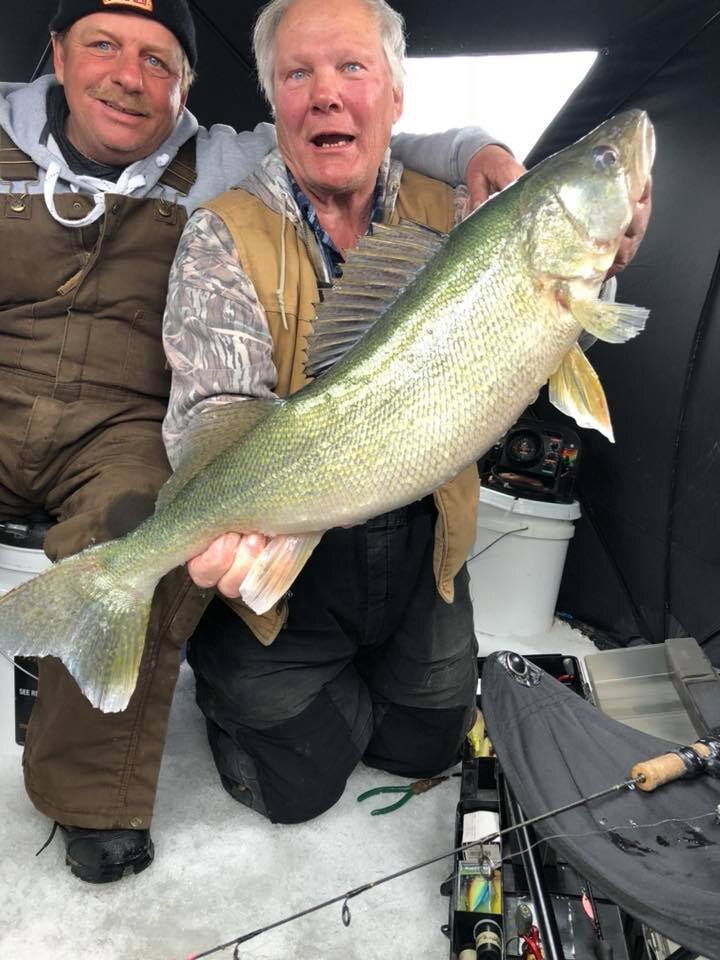

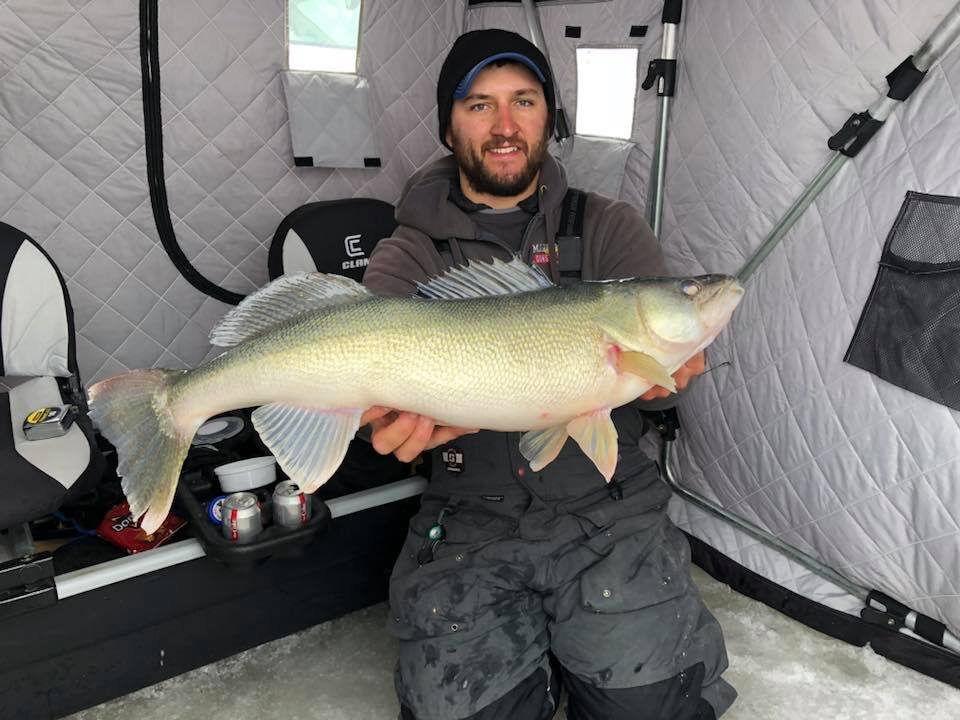
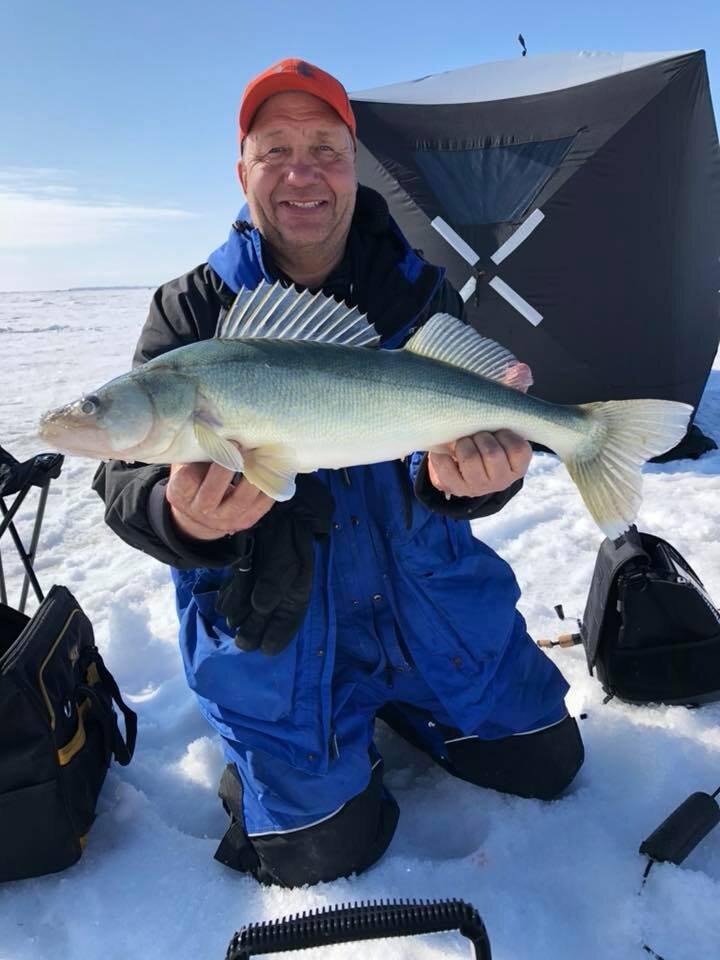
Lake Winnipeg is a destination that truly any ice angler can conquer. It will take in-depth planning, extra gear, and some patience, but at the end of the day – there isn’t a better place to land a 30″ walleye.
There are plenty of accommodations, easy accessibility, and if the weather is right, you can even fish from the truck. It doesn’t get any easier than that.
Best of all, there are large numbers of big fish on this lake. You don’t need to sit perfectly on structure, and you don’t need to have a perfect technique. You simply need to put your time into fishing it.
Pack and plan accordingly, be ready to be mobile, prepare for those emergency situations, and get out and hit the ice.




